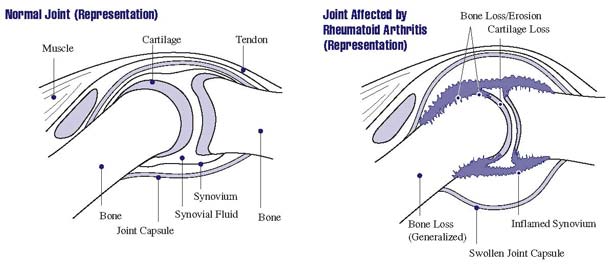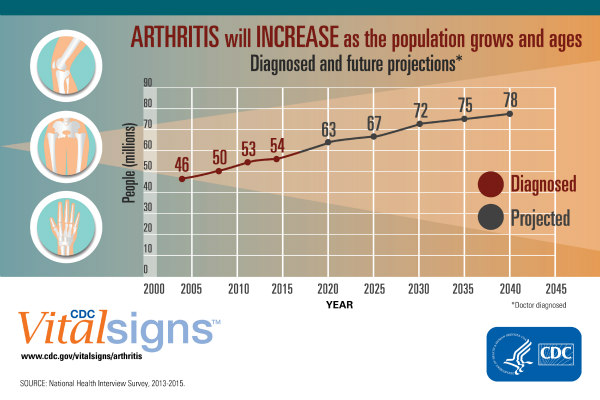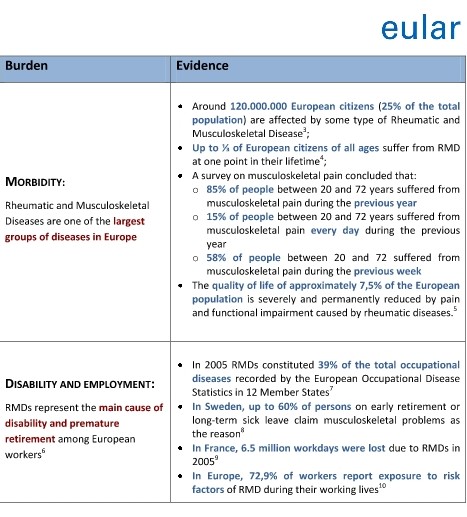…more studies are needed to address the prevalence and the true burden of the disease in Nigeria.
In public health system, diseases such as cancer, HIV/AIDS, cardiovascular diseases amongst other attract most of the attention from the public opinion, policy makers, as well as scientific institutions and research organisations. These diseases are usually high on the agenda as they lead to millions of deaths every year.
However, there are other chronic diseases that are not attracting enough attention as they ought to. These public health diseases also impact negatively on the productivity of our economies, the sustainability of our health and social security systems and as well as the quality of life of people and their relatives. In addition, these diseases produce an enormous burden on individuals, families and societies.
Arthritis is among these group of health issues that is very common but not well understood and therefore attracts lesser attention from the government and relevant authorities.
Arthritis is often seen as a minor health problem and has been neglected in research and resource allocation throughout Africa despite potentially fatal systemic manifestations.
Every year all over the world, October 12 is set aside as the World Arthritis Day to create awareness about the disease.
National Institute of Arthritis and Musculoskeletal and Skin Diseases termed arthritis as any disorder that affects the joints.
According to experts, it is a painful and degenerative condition marked by inflammation in the joints that causes stiffness. It is also a disease that has more than 100 different types and related conditions. It get worse with age.
The different types of arthritis are : rheumatoid, polyarteritis, osteoarthritis, juvenile arthritis, psoriatic, gouty and ankylosing spondylitis.

The Centers for Disease Control and Prevention, CDC combined data from the National Health Interview Survey (NHIS) 2013-2015 revealed that an estimated 22.7% (34.4 million) of adults had doctor-diagnosed arthritis with significantly higher age adjusted prevalence in women (23.5%) than in men (18.1%).
If left untreated, it can lead to extensive erosion of the cartilage causing deformity and disability.This disability can lead to a loss of career and sources of income which is a big problem in low income setting.
In the United States, The National Arthritis Data work group in November 12, 2019 noted that the prevalence of arthritis has increased, and it will continue to climb as the baby boomer generation ages. Since arthritis is the most common cause of disability in America, analysts are trying to gain perspective on the looming disease burden and its impact on nation’s health care and public health systems by estimating disease prevalence.

Future Arthritis Burden, by year 2040, an estimated 78.4 million (25.9% of the projected total adult population) adults aged 18 years and older will have doctor-diagnosed arthritis, compared with the 54.4 million adults in 2013-2015.
In Europe, according to the European League against Rheumatism (EULAR), more than 120 million people (one out of four citizens) suffer from a chronic musculoskeletal condition. Many of them have developed some sort of disability or impairment, which reduces their mobility, limits their Independence and in a large number of cases, prevents them from continuing normal working and social lives.
Up to ⅓ of European citizens of all ages suffer from arthritis at one point in their lifetime.

A survey on musculoskeletal pain in Europe concluded that 85% of people between 20 and 72 years suffered from musculoskeletal pain during the previous year. 15% of people between 20 and 72 years suffered from musculoskeletal pain everyday during the previous year. 58% of people between 20 and 72 suffered from musculoskeletal pain the previous week.
The quality of life of approximately 7.5% of the European population is severely and permanently reduced by pain and functional impairment caused by rheumatic diseases.
Africa faces many health challenges despite sustained growth and development over the past decade. Contributory factors are the lack of financial resources, an inadequate health professional workforce, a high burden of communicable diseases, and an increasing burden of non-communicable diseases.
Although prevalence data on arthritis in Africa remain scarce, disability due to Musculoskeletal disorders has increased by 45% from 1990 to 2019 and oestoarthritis is listed as the fastest increasing major health condition and ranked second as cause of disability by World Health Organization.
To estimate the burden of disability caused by arthritis, an accurate population prevalence record is required. Despite the overwhelming reports on the rising prevalence of musculoskeletal conditions, data from Africa are lacking and underestimated.
However, less is known about arthritis prevalence or determinants in Nigeria, but in estimating the burden of rheumatoid arthritis in Africa in 2006, small studies by International Society for Global Health (ISGH) from Nigeria, Liberia, and South Africa showed a high male to female ratio that was inconsistent with global trends and literature.
Similarly in estimating the burden for osteoarthritis in Africa only one study from South Africa was used, emphasizing the paucity of data in Africa.
The majority of the studies were from South Africa (44.4%, 12/27). Rheumatoid arthritis in urban settings ranged from 0.1% in Algeria, 0.6% in the DRC, to a meta-analysis overall prevalence of 2.5% in South Africa, and in rural settings ranged from a meta-analysis overall prevalence of 0.07% in South Africa, 0.3% in Egypt, to 0.4% in Lesotho.
Osteoarthritis was the most prevalent form of arthritis and in urban settings, it was 55.1% in South Africa and in rural settings, all in South Africa, ranged from 29.5%, 29.7%, up to 82.7% among adults aged over 65 years. Other results include highest prevalence of 33.1% for knee osteoarthritis in rural South Africa, 0.1% for ankylosing spondylitis in rural South Africa, 4.4% for psoriatic arthritis in urban South Africa, 0.7% for gout in urban South Africa, and 0.3% for juvenile idiopathic arthritis in urban Egypt. A third of the included studies had a low risk of bias (33.3%, 9/27), 40.8% (11/27) moderate risk, and 25.9% (7/27) had a high risk of bias.
To date, the exact prevalence of arthritis is not well known. Therefore, as Nigeria joins the rest of the world today to mark 2020 World Arthritis Day, we call on Nigerian health sector and survey groups to conduct more basic research and translational research in arthritis at least in the same way as other major diseases. Also, more studies are needed to address the prevalence and the true burden of the disease in Nigeria.





